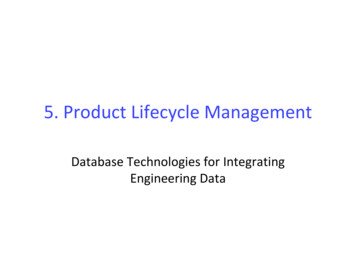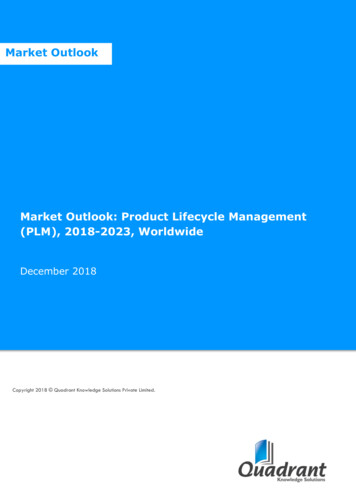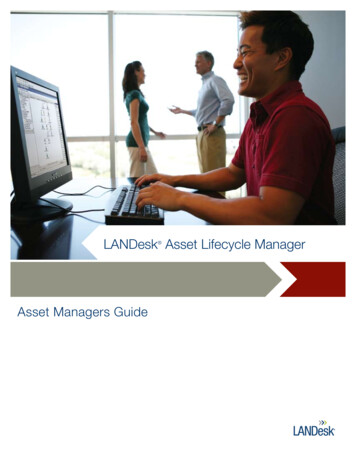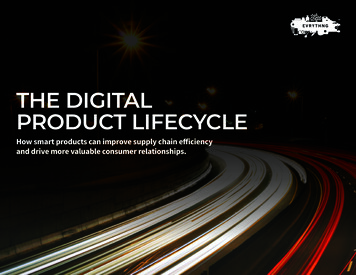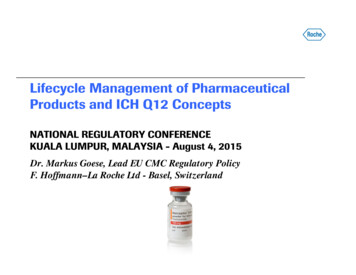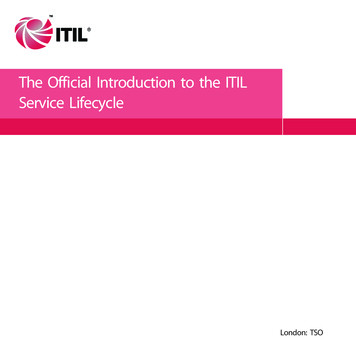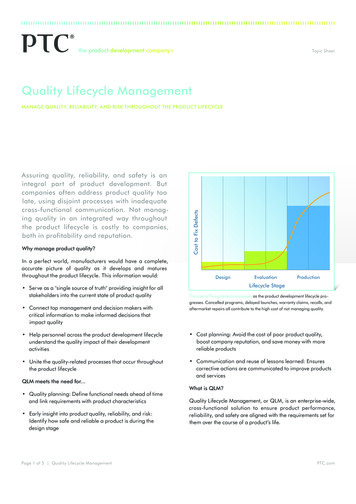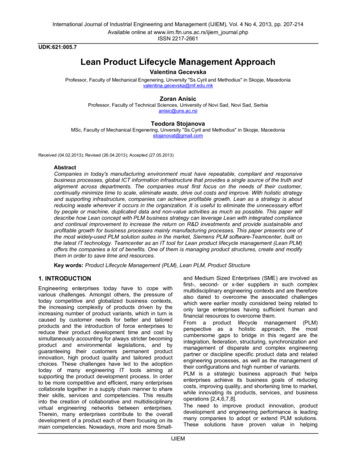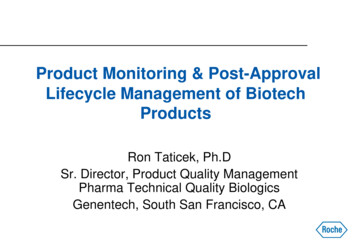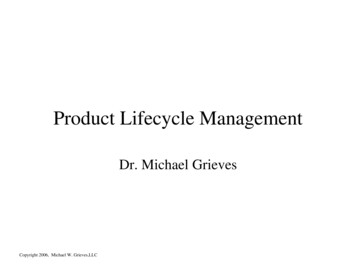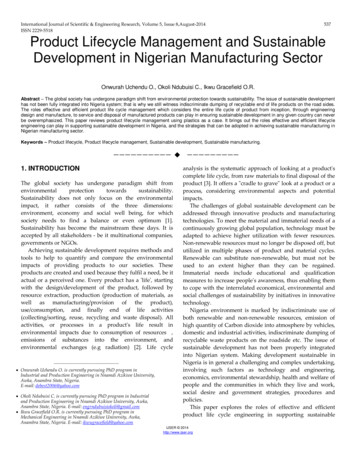
Transcription
International Journal of Scientific & Engineering Research, Volume 5, Issue 8,August-2014ISSN 2229-5518537Product Lifecycle Management and SustainableDevelopment in Nigerian Manufacturing SectorOnwurah Uchendu O., Okoli Ndubuisi C., Ikwu Gracefield O.R.Abstract ‒ The global society has undergone paradigm shift from environmental protection towards sustainability. The issue of sustainable developmenthas not been fully integrated into Nigeria system; that is why we still witness indiscriminate dumping of recyclable end of life products on the road sides.The roles effective and efficient product life cycle management which considers the entire life cycle of product from inception, through engineeringdesign and manufacture, to service and disposal of manufactured products can play in ensuring sustainable development in any given country can neverbe overemphasized. This paper reviews product lifecycle management using plastics as a case. It brings out the roles effective and efficient lifecycleengineering can play in supporting sustainable development in Nigeria, and the strategies that can be adopted in achieving sustainable manufacturing inNigerian manufacturing sector.Keywords ‒ Product lifecycle, Product lifecycle management, Sustainable development, Sustainable manufacturing.—————————— —————————1. INTRODUCTIONThe global society has undergone paradigm shift ustainability does not only focus on the environmentalimpact, it rather consists of the three dimensions:environment, economy and social well being, for whichsociety needs to find a balance or even optimum [1].Sustainability has become the mainstream these days. It isaccepted by all stakeholders be it multinational companies,governments or NGOs.Achieving sustainable development requires methods andtools to help to quantify and compare the environmentalimpacts of providing products to our societies. Theseproducts are created and used because they fulfil a need, be itactual or a perceived one. Every product has a 'life', startingwith the design/development of the product, followed byresource extraction, production (production of materials, aswell as manufacturing/provision of the product),use/consumption, and finally end of life activities(collecting/sorting, reuse, recycling and waste disposal). Allactivities, or processes in a product's life result inenvironmental impacts due to consumption of resources ,emissions of substances into the environment, andenvironmental exchanges (e.g radiation) [2]. Life — Onwurah Uchendu O. is currently pursuing PhD program inIndustrial and Production Engineering in Nnamdi Azikiwe University,Awka, Anambra State, Nigeria.E-mail: debest2006@yahoo.com Okoli Ndubuisi C. is currently pursuing PhD program in Industrialand Production Engineering in Nnamdi Azikiwe University, Awka,Anambra State, Nigeria. E-mail: engrndubuisiokoli@gmail.com Ikwu Gracefield O.R. is currently pursuing PhD program inMechanical Engineering in Nnamdi Azikiwe University, Awka,Anambra State, Nigeria. E-mail: ikwugracefield@yahoo.comanalysis is the systematic approach of looking at a product'scomplete life cycle, from raw materials to final disposal of theproduct [3]. It offers a ʺcradle to graveʺ look at a product or aprocess, considering environmental aspects and potentialimpacts.The challenges of global sustainable development can beaddressed through innovative products and manufacturingtechnologies. To meet the material and immaterial needs of acontinuously growing global population, technology must beadapted to achieve higher utilization with fewer resources.Non-renewable resources must no longer be disposed off, bututilized in multiple phases of product and material cycles.Renewable can substitute non-renewable, but must not beused to an extent higher than they can be regained.Immaterial needs include educational and qualificationmeasures to increase people's awareness, thus enabling themto cope with the interrelated economical, environmental andsocial challenges of sustainability by initiatives in innovativetechnology.Nigeria environment is marked by indiscriminate use ofboth renewable and non-renewable resources, emission ofhigh quantity of Carbon dioxide into atmosphere by vehicles,domestic and industrial activities, indiscriminate dumping ofrecyclable waste products on the roadside etc. The issue ofsustainable development has not been properly integratedinto Nigerian system. Making development sustainable inNigeria is in general a challenging and complex undertaking,involving such factors as technology and engineering,economics, environmental stewardship, health and welfare ofpeople and the communities in which they live and work,social desire and government strategies, procedures andpolicies.This paper explores the roles of effective and efficientproduct life cycle engineering in supporting sustainableIJSER 2014http://www.ijser.org
International Journal of Scientific & Engineering Research, Volume 5, Issue 8,August-2014ISSN 2229-5518development in Nigeria. The rest of this paper is arranged asfollows: section 2 covers the concept of sustainabledevelopment. Section 3 discusses product life cycle,explaining all the phases in product life cycle. Section 4discusses Product life cycle management using life cyclemanagement of plastics products as a case. Section 5 discussesthe roles of effective and efficient life cycle engineering insupporting sustainable development in Nigeria. Section 6looks at sustainable manufacturing including possible waysor strategies for achieving it in Nigeria. Section 7 concludesthe paper.3. PRODUCT LIFECYCLEProduct life cycle generally indicates the whole set of phaseswhich could be recognized as independent stages to bepassed/followed/performed by a product, from its cradle toits grave.According to Kiritsis et al. [9], product life cycle consists ofthree main phases:1.2. THE CONCEPT OF SUSTAINABLEDEVELOPMENTThe United Nations World Commission on Environment andDevelopment (WCED) in its 1987 report ʺOur CommonFutureʺ The Bruntland Commission [4] defines sustainabledevelopment as ʺdevelopment that meets the needs of thepresent without compromising the ability of the futuregenerations to meet their own needsʺ. This definition seessustainable development as a mission that seeks to meet theneeds and aspirations of the present without compromisingthe ability to those of the future. Under the principles of theUnited Nations Charter the Millennium Declarationidentified principles and treaties on sustainable development,including economic development, social development, andenvironmental protection.Needham [5] referred to sustainable development as theability to meet the needs of the present while contributing tothe future generations' needs. There is an additional focus onthe present generation responsibility to improve the futuregeneration's life by restoring the previous ecosystem andresisting contributing to further ecosystem degradation.According to Nyere (1970) in Alebiosu and Famuyiwa [6],sustainable development is characterised by a promotion ofthe equality of the people; absence of exploitation; dignityand respect for human beings; promotion of nationalindependence and self-reliance; and transformation ofeconomic growth to social development.Ajayi [7] posits that sustainable development is hung onthree pillars of environment, economy and society. He arguedthat education tuned towards environment and sustainabilityshould be understood as the common basis and theprerequisite foundation of the entire structure of sustainabledevelopment. In the words of Okpetu and Nwankwo [8],sustainable development should bring about a lastingimprovement in the quality of life and not just short-termimprovement that disappears rapidly at a project cycle.5382.3.Beginning of Life (BOL); including design andmanufacturing. Design is a multi level phase, since itcomprises product, process and plant design.Product development requires a computationalframework that enables the capture, representation,retrieval and reuse of product and processknowledge. Manufacturing means production ofartefacts and related plant internal logistic. At thisstage, product information has to be shared along theproduction chain, to be synchronised with futureupdates.Middle ‒of ‒life (MOL): Including distribution(external logistic), use and support (in terms of repairand maintenance). In its life, a product passes fromthe company's hands to service suppliers (e.g.transportation suppliers, but also after‒salesassistance suppliers) to arrive at customer's hand.These passages could happen many times, inreiterative ways. Product usage data are to becollected, transformed and used for various purposesin the service chain. For example, data on productbehaviour during the usage phase can be fed back inBOL and used for design improvement.End‒of‒life (EOL): This is where products are retired actually recollected in the company's hands (reverselogistic) ‒ in order to be recycled (disassembled,remanufactured, reused, etc) or disposed. Recyclingand dismissal activities require and provide usefulinformation on product components, materials andresources from/to the design and manufacturingstages. Many different actors are involved in thisphase (company's service suppliers; customer'senvironment sensibility has a relevant role to themanagement of such phase).4. PRODUCT LIFECYCLE MANAGEMENTIn industry, product life cycle management (PLM) is theprocess of managing the entire lifecycle of a product frominception, through engineering design and manufacture, toIJSER 2014http://www.ijser.org
International Journal of Scientific & Engineering Research, Volume 5, Issue 8,August-2014ISSN 2229-5518service and disposal of manufactured products [10]. It is asystematic concept for the integrated management of allproduct related information and processes across theextended enterprise through the entire lifecycle, from conceptand design, to production, distribution, maintenance, andretirement [11], [12]. Product lifecycle management integratespeople, data, processes and business systems and provides aproduct information backbone for companies and theirextended enterprise [10]. The lifecycle management of thethree phases stated above are discussed below using plasticproducts as a case.4.1 Plastics Products Lifecycle ManagementPlastics are known as one of the most resource efficient andflexible materials available in Nigeria. Their low weight,strength and versatility make them applicable to a broadrange of uses, ranging from packaging (e.g. crates, pallets,bottles, and foil), household (e.g. micro‒proof containers),construction (e.g. insulation, pipes/guttering, PVC windows),furniture, transport (e.g. automobile interior/exterior parts),electrical goods (e.g. televisions, mobile phone), to medicaland space travel. Due to its diverse usage, it is perhaps notsurprising that each of us consumes in excess of 100Kg ofplastic every year [13].In terms of manufacturing plastic products, a range ofdifferent technologies are applied, including injectionmoulding, blow moulding, rota moulding, thermo setprocessing, extrusion, thermoforming and vacuum forming.All of these technologies typically involve raw materialspolymer being shaped in a mould or die using a combinationof heat, pressure and cooling [13]. The lifecycle of plasticproducts, like any other product has three phases: Beginningof life, middle of life, and end of life. The various phases ofplastic product are discussed below.4.1.1 Product Beginning of Life ManagementThis phase involves product design and manufacture.Product design is one of the most important sectorsinfluencing global sustainability, as almost all the productsconsumed by people are outputs of the product developmentprocess. Product development requires a computationalframework that enables the capture, representation, retrievaland reuse of product and process knowledge.Product manufacturing process is the main stage in thelifecycle that consumes resources directly and producesenvironmental pollution as well as being the main factor thataffects the result of enterprise performance in terms of539sustainable development [14]. Efforts to minimize theenvironmental impacts of plastic manufacturing processescan roughly be classified into three categories [15]:1. Processimprovement and optimization, 2. New process development,and 3. Process planning. Traditional manufacturing processesare generally designed for high performance and low costwith little attention paid to environmental issues. Forexample, metalworking fluids are widely used in a variety ofmachining operations, and fluid delivery is the commonpractice. Skerlos et al. [16] reviewed advances in thedevelopment of alternative metalworking fluid deliverystrategies for sustainable manufacturing. They pointed outthat it is possible to design more sustainable metalworkingfluid systems either by extending dramatically the in‒uselifetime of water based fluids, or better still, by switching togas‒based (air) minimum quantity.In plastic manufacturing, one of the most important stepsin converting a design concept into a manufactured product isprocess planning [17].The manufacturing plan outlines theselection of the manufacturing processes, sequencing of theprocesses, and parameters for each manufacturing process.Similar to product design, one can argue that in the earlystage of process planning, selection and sequence of majorprocesses are more critical than the parameters optimizationof processes involved with regard to performance, includingthat of sustainability.4.1.2 Middle of Life ManagementPlastic products middle ‒of ‒life (MOL) phase includesdistribution (external logistic), use and support (in terms ofrepair and maintenance). In its life, a product passes from thecompany's hands to service suppliers (e.g. transportationsuppliers, but also after‒sales assistance suppliers) to arrive atcustomer's hand. Efforts towards sustainable plasticsrealization must take into account manufacturing activities atthree different levels: process, factory and supply chain [18].A sustainable supply chain should be designed for cost andenvironmental impact minimization.The scope of green supply chain management practiceimplementation ranges from green purchasing to integratedlife cycle management supply chains flowing from supplier,to manufacturer, and to customer, and then closing the loopwith reverse logistics [19]. The problem does not only involvethe willingness and ability of customers to return productsbut also the existence of a streamlined reverse supply chain[20].The plastic entire lifecycle has to be carefully considered insupply chain management. A company can select thoseIJSER 2014http://www.ijser.org
International Journal of Scientific & Engineering Research, Volume 5, Issue 8,August-2014ISSN 2229-5518suppliers that generate the least pollution in each individualphase. Gehin et al. [21] introduced a method to deconstructthe supply chain in order to target the product's phase(distribution, packaging etc.) that carried the mostenvironmental impact. This paves way to a concerted effort toreduce the total environmental load of the product incooperation with suppliers, distributors, users, recyclingcompanies, and waste‒processing firms. Product usage dataare to be collected, transformed and used for variouspurposes in the service chain. For example, data on productbehaviour during the usage phase can be fed back in BOL andused for design improvement.4.1.3 Product End‒of‒life ManagementManaging end of life products has become a field of vironmental regulations urge stronger stewardship forproduct retirement, disposal can no longer be the primaryretirement strategy for end‒of‒life products. Manufacturersneed to find more proactive ways to reduce waste and saveresources. EOL management of used products is a promisingsolution to this problem.EOL management is the process of converting end‒of‒lifeproducts into remarkable products, components, or materials540[22]. It enables manufacturers to comply with legislationwhile gaining some economic advantage as well.EOL management starts from product take‒back which isthe process of collecting products that reach an end‒of‒lifestatus. White et al. [23] presented an overview of challengesin end‒of‒life management at each stage of the productrecovery process and showed that better information aboutthe product design, product quality, and timing can improveEOL opportunities. Since product take‒back determines thevolume, type, and quality of feedback processed later in therecovery process, how many cores and which types of coresshould be acquired are major concerns for manufacturers.After product take‒back, the collected plastic products (seefigure 1) move to a recovery plant and pass through EOLrecovery process (see figure 2). After testing functional andcosmetic quality, unrecoverable units move to disposal sitesfor landfills or incineration (see Figure 3). Recoverableproducts are reprocessed with various options, includingreuse, refurbishing, remanufacturing, and material recovery.Finally, recovered units are sent to various demand sites, suchas manufacturing plants, second-hand markets or componentmarkets.Fig. 1: Collection site for waste ProductsIJSER 2014http://www.ijser.org
International Journal of Scientific & Engineering Research, Volume 5, Issue 8,August-2014ISSN 2229-5518541Fig. 2: Plastic Product Recycling (Source: www.Piranha.com)Fig. 3: Disposal site for unrecoverable Products5. THE ROLES OF PRODUCT LIFECYCLEENGINEERING IN SUPPORTING SUSTAINABLEDEVELOPMENT IN NIGERIAEffective and efficient product life cycle engineering is everyimportant tool in achieving sustainable development in anycountry. To achieve sustainable development in Nigeria,effective and efficient product life cycle engineering has thefollowing roles to play:1. Effective and efficient product life cycle engineeringplays important roles in reducing the totalenvironmental burden from product development byIJSER 2014http://www.ijser.org2.finding sustainable solutions for the needs of thesociety. Environmental burden has two impactcategories: resource depletion and ecological andhealth effects [24]. With effective and efficient lifecycle engineering in Nigeria, products that will notpose ecological and health challenges will bedesigned, manufactured and recovered for otherpurpose (reuse, remanufacture, recycle etc.) at theend of its useful life.Effective and efficient life cycle engineering plays animportant role in conservation of resources.Depletion of non-renewable resources and overuse ofrenewable resources limit their availability to future
International Journal of Scientific & Engineering Research, Volume 5, Issue 8,August-2014ISSN 2229-55183.4.and future generations. There can be no productdevelopment without available resources. Productlifecycle is focussed on promotion of preventionstrategy that minimizes raw material losses andreduces long-term liabilities. With proper lifecyclemanagement in place in Nigeria, the rate at whichnon-renewable resources are being used will becheckmated leading to conservation of resources.Product life cycle engineering plays important role inrecovery, recycling, remanufacturing and reuse ofwaste products. Recovery is a process of restoringmaterials found in waste stream to a beneficial use,which may be for purposes other than the originaluse. Recycle is a resource recovery method involvingthe collection and treatment of waste products foruse as raw material in the manufacture of the same orsimilar product. Reuse means using waste as a rawmaterial in a different process without any structuralchanges. Remanufacturing is substantial rebuildingor refurbishment of machines, devices or otherobjects to bring them to a reusable or almost a newstate. Effective and efficient life cycle engineeringwill help in ensuring end of life product recovery,recycling, remanufacturing and reuse in Nigeria,hence ensuring sustainable development in Nigeria.Take for instance, recycling and re-utilization ofwaste plastics have several advantages. Recyclingand re-utilization of waste lead to a reduction of theuse of virgin materials and of the use of energy, thusalso a reduction of carbon dioxide emissions.Economically, in some cases, plastics recycling maybe profitable. However, a number of factors cancomplicate the practice of plastics recycling, such asthe collection of the plastics waste, separation ofdifferent types of plastics, cleaning of the waste andpossible pollution of the plastics. But, propercollaboration with the necessary stakeholders willhelp to eliminate the above factors. Reusing plastic ispreferable to recycling as it uses less energy andfewer resources.Effective and efficient product life cycle engineeringwill help in achieving sustainable developmentthrough sustainable use of resources, pollutionprevention, maintenance of ecosystem structure andfunction, and environmental equity. Effective andefficient life cycle engineering ensures the design andmanufacture of products that have few parts withrenewable raw materials and will also ensure that the5.542rate at which these materials are being used does notexceed the rate at which they are replenished.Product lifecycle engineering plays important rolesin product design and development, manufacturing,use and dismissal. Product life cycle engineeringwhich is an integrated approach takes intoconsideration sustainability objectives in productdesign, manufacturing, use and end of life of aproduct. If this approach whereby companies orindustries are expected to incorporate sustainabilitymeasures starting from the beginning of life to end oflife their products, are properly employed in Nigeria,it will no in small measure support sustainabledevelopment of this country Nigeria.6. SUSTAINABLE MANUFACTURINGThe link between manufacturing and its operations to thenatural environment is becoming more and more recognized.Progress, profitability, productivity and environmentalstewardship are now seen as needing consideration bymanufacturing organizations [25]. Improving tainingprofitability and productivity are increasingly viewed asstrategic goals of manufacturing companies [26]. Sustainablemanufacturing has obtained many attentions from theindustrial and research communities, as the plethora ofstrategies, methods, procedures and tools existing inliterature demonstrate. According to US Department ofCommerce (www.trade.gov), sustainable manufacturing isdefined as the creation of manufactured products that usesprocesses that minimize negative environmental impact,conserve energy and natural resources that are safe foremployees, communities and consumers and areeconomically sound. Glavic and Lukman [27] outline some ofthe many contributions that have been developed in the ambitof sustainable manufacturing practices, in terms of principles,tools and strategies: Principles are fundamental concepts that serve as abasis for actions, and as an essential framework forthe establishment of a more complex system. Theprinciples include: Reuse, Recycle, Recover, Repair,Regeneration, Remanufacturing etc. Tools contain a group or cluster of principles relatedto the same topic, building a more complex system,showing how to apply specific practices in order tocontribute to an improved industrial performance.The tools include: design for environment, greenmanufacturing,greenchemistry,wasteIJSER 2014http://www.ijser.org
International Journal of Scientific & Engineering Research, Volume 5, Issue 8,August-2014ISSN 2229-5518 minimization, zero emission, life cycle assessment,cleaner production, life cycle management etc.Strategies consist of approaches and systemsconnected together that are to be met in order toincorporate the principle of sustainability intoeveryday business activities. The strategies include:Pollution prevention (P2), Industrial Ecology,Environmentally Conscious Manufacturing, TotalQuality Environmental Management etc. [27].6.1 Factors Affecting Sustainable ManufacturingThe successful implementation of sustainability intomanufacturing organizations is dependent on many factors.Rosen and Kishawy [26] presented some of the factors thataffect implementation of sustainability into manufacturing.They include:1. Information: The quantitative and qualitativeinformation required to make assessments is needed,for example, the quantity and type of metal a processuses, the quantity and type of pollutants emitted.However, such information is not always readilyavailable and can be sometimes be difficult if notimpossible to acquire.2. Management and Culture: Sustainability issues, forexample, environmental stewardship efforts, tend tobe dealt with in specialized departments rather thanholistically by management. This can lead toinconsistent application and tends to discourage thedevelopment of a sustainability oriented culture inthe organization.3. Procedures: Decision makers and staff are often notprovided with the methodologies and proceduresneeded to ensure an organization's sustainabilityobjectives and strategies are applied effectively,efficiently, consistently and robustly. One reason forthis problem is that the number of variables to betaken into account in decision making is usually verylarge.543discussed below if apply in Nigeria manufacturing sector willhelp in achieving sustainable manufacturing in industries.1. Approach: A more comprehensive, broad andintegrated approach is needed for sustainability,which encompasses economic, social, environmentaland other relevant considerations. An approach thatgoes beyond individual companies can make themanufacturing industry more sustainable.2. Methods and Tools: Enhanced methods and tools formanufacturing are needed to foster and supportsustainability.3. Data: More detailed, comprehensive and robust dataare needed to support environmental impact andsustainability assessments and measures across theoverall product lifecycle. Such data needs to bestandardized where feasible.4. Manufacturing Company Practices: Manufacturingcompanies should incorporate sustainability intotheir practices holistically. Practices that would behelpfulinclude:improvedmeasuringandmonitoring of sustainability indicators by companies,company policies and governance that focus onsustainable development, improved efforts to controla company's environmental impact, establishing asustainability support company culture and workingconditions, enhancing awareness of sustainabilityamong suppliers and customers, responding to theirrequirements and to measures, and engaging thecommunity to promote sustainable development.5. Government Policies: Government and relevantagencies need to incorporate into policies, nability, environmental factors, and cleanprocesses. This requires cooperation between internaland external partners.6. Research: Significant collaborative research is neededin industry and academia in the fields tal impact.6.2 Achieving Sustainable Development in NigerianManufacturing Sector7. CONCLUSIONThe present section highlights the importance of integratingsustainability, design for environment, life cycle assessmentand other tools with manufacturing and relevant decisionmaking structures in Nigerian manufacturing sector. Rosenand Kishawy [26] outline several specific needs or strategiesto enhance manufacturing sustainability. These strategies asMaking development sustainable in Nigeria is in general achallenging and complex undertaking, involving such factorsas technology and engineering, economics, environmentalstewardship, health and welfare of people and thecommunities in which they live and work, social desire andgovernment strategies, procedures and policies. This paperviewed the roles effective and efficient life cycle engineeringIJSER 2014http://www.ijser.org
International Journal of Scientific & Engineering Research, Volume 5, Issue 8,August-2014544ISSN 2229-551815. K. Ramani, D. Ramanujan, W. Bernstein, F. Zhao, J. Sutherland,can play in achieving sustainable development in Nigeria.C. Handwerker, J. Choi, H. Kim and D. Thurston, “IntegratedThe roles took into consideration three dimensions ofSustainable Life Cycle Design: A Review,” Journal ofsustainability: environment, economy, and social well beingMechanical Design, vol. 132, 2010.from the cradle to grave of a product. This paper looked at16. S.J. Skerlos, P. Adriaens, K. Hayes, J. Zimmerman, and F. Zhao,plastics lifecycle management covering the three phases of“Ecological Material and Green Manufacturing: Design andTechnology for Metalworking Fluid Systems,” Proceedings ofproduct lifecycle and also took a closer look at some of thetheWorld Engineering Congress, Shanghai, China, 2004.strategies or means that can be adopted in making Nigerian17. B. Denkena, M. Shpitalni, P. Kowalski, Z. Molcho and Y.manufacturing sector sustainable.Zipori, “Knowledge Management in Process Planning,” CIRPAnn., vol. 56, no.1, pp175‒180, 2007.REFERENCES18. D.T. Pham, P.T.N. Pham and A. Thomas, “IntegratedProduction Machines and Systems ‒ Beyond Lean1.M. Finkbeiner, “Towards Life Cycle SustainabilityManufacturing,” Intl. Journal of Manufacturing TechnologyManagement,” Springer Science Business Media, 2011.Management, Vol. 19, no.6, Pp 695‒711, 2008.2.G. Rebitzer, T. Ekvall, R. Frischeknece and D. Hunkeler, “Life19. Q.H. Zhu, J. Sarkis, and K.H. Lai, “Confirmation of aCycle Assessment Part 1: Framework, Goal and ScopeMeasurement Model for Green Supply Chain ons,”Practices Implementation,” Intl. Journal of ProductionEnvironmental International, vol.30, pp 701‒720
Product lifecycle management integrates people, data, processes and business systems and provides a product information backbone for companies and their extended enterprise [10]. The lifecycle management of the three phases stated ab
